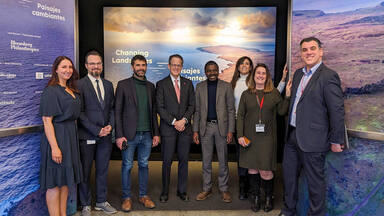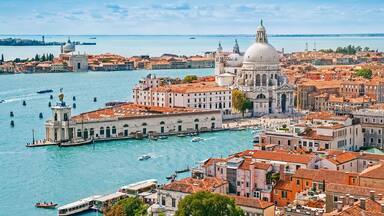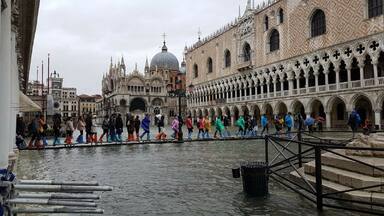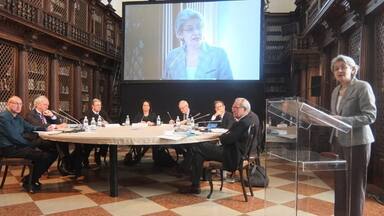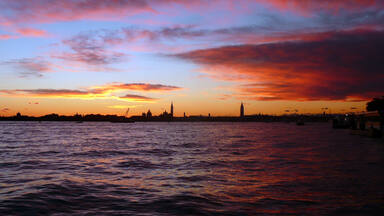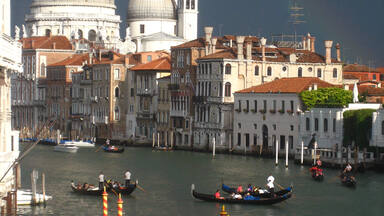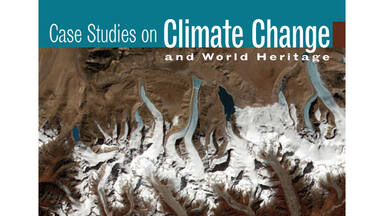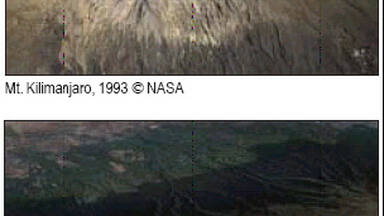Venice and its Lagoon
Venice and its Lagoon
Founded in the 5th century and spread over 118 small islands, Venice became a major maritime power in the 10th century. The whole city is an extraordinary architectural masterpiece in which even the smallest building contains works by some of the world's greatest artists such as Giorgione, Titian, Tintoretto, Veronese and others.
Description is available under license CC-BY-SA IGO 3.0
Venise et sa lagune
La ville insulaire fondée au Ve siècle s'étend sur 118 îlots. Elle est devenue une grande puissance maritime au Xe siècle. Venise dans son ensemble est un extraordinaire chef-d'œuvre architectural car même le plus petit monument renferme des œuvres de certains des plus grands artistes du monde, tels Giorgione, Titien, le Tintoret, Véronèse et d'autres.
Description is available under license CC-BY-SA IGO 3.0
البندقية وبحيرتها الشاطئية
تمتدّ هذه المدينة، القائمة فوق أرخبيل، والتي تأسست في القرن الخامس، على 118 جزيرة. وقد أصبحت قوة بحرية كبيرة في القرن العاشر. وتشكل البندقية بمجملها تحفة هندسية معمارية مذهلة فحتى النصب الأصغر فيها يحتوي على أعمال لبعض من كبار فنّاني العالم مثل دجورجوني ووتيتيان ولو تانتوريه وفيرونيز وغيرهم.
source: UNESCO/CPE
Description is available under license CC-BY-SA IGO 3.0
威尼斯及泻湖
威尼斯始建于5世纪,由118个小岛构成,10世纪时成为当时最主要的海上力量。整个威尼斯城就是一幅非凡的建筑杰作,即便是城中最不起眼的建筑也可能是出自诸如焦尔焦内(Giorgione)、提香(Titian)、丁托列托(Tintoretto)、韦罗内塞(Veronese)等世界大师之手。
source: UNESCO/CPE
Description is available under license CC-BY-SA IGO 3.0
Венеция и ее лагуна
Основанная в V в. и расположенная на 118 маленьких островах, Венеция в X в. стала крупной морской державой. Весь город представляет собой выдающийся архитектурный ансамбль, где практически в каждом здании можно найти работы таких всемирно известных художников как Джорджоне, Тициан, Тинторетто, Веронезе и др.
source: UNESCO/CPE
Description is available under license CC-BY-SA IGO 3.0
Venecia y su Laguna
Fundada en el siglo V, esta ciudad lacustre comprende 118 islotes. En el siglo X se convirtió en una gran potencia marítima. Venecia es, en su conjunto, una obra maestra de la arquitectura y hasta los más pequeños de sus monumentos albergan obras de los más grandes artistas de todos los tiempos, como Giorgione, Tiziano, Veronés y el Tintoretto, entre otros.
source: UNESCO/CPE
Description is available under license CC-BY-SA IGO 3.0
ヴェネツィアとその潟
source: NFUAJ
Venetië en haar lagune
Source: unesco.nl
Outstanding Universal Value
Brief synthesis
The UNESCO World Heritage property comprises the city of Venice and its lagoon situated in the Veneto Region of Northeast Italy. Founded in the 5th century AD and spread over 118 small islands, Venice became a major maritime power in the 10th century. The whole city is an extraordinary architectural masterpiece in which even the smallest building contains works by some of the world's greatest artists such as Giorgione, Titian, Tintoretto, Veronese and others.
In this lagoon covering 70,176.4 ha, nature and history have been closely linked since the 5th century when Venetian populations, to escape barbarian raids, found refuge on the sandy islands of Torcello, Jesolo and Malamocco. These temporary settlements gradually became permanent and the initial refuge of the land-dwelling peasants and fishermen became a maritime power. Over the centuries, during the entire period of the expansion of Venice, when it was obliged to defend its trading markets against the commercial undertakings of the Arabs, the Genoese and the Ottoman Turks, Venice never ceased to consolidate its position in the lagoon.
In this inland sea that has continuously been under threat, rises amid a tiny archipelago at the very edge of the waves one of the most extraordinary built-up areas of the Middle Ages. From Torcello to the north to Chioggia to the south, almost every small island had its own settlement, town, fishing village and artisan village (Murano). However, at the heart of the lagoon, Venice itself stood as one of the greatest capitals in the medieval world. When a group of tiny islands were consolidated and organized in a unique urban system, nothing remained of the primitive topography but what became canals, such as the Giudecca Canal, St Mark's Canal and the Great Canal, and a network of small rii that are the veritable arteries of a city on water.
Venice and its lagoon landscape is the result of a dynamic process which illustrates the interaction between people and the ecosystem of their natural environment over time. Human interventions show high technical and creative skills in the realization of the hydraulic and architectural works in the lagoon area. The unique cultural heritage accumulated in the lagoon over the centuries is attested by the discovery of important archaeological settlements in the Altino area and other sites on the mainland, which were important communication and trade hubs.
Venice and its lagoon form an inseparable whole of which the city of Venice is the pulsating historic heart and a unique artistic achievement. The influence of Venice on the development of architecture and monumental arts has been considerable..
Criterion (i): Venice is a unique artistic achievement. The city is built on 118 small islands and seems to float on the waters of the lagoon, composing an unforgettable landscape whose imponderable beauty inspired Canaletto, Guardi, Turner and many other painters. The lagoon of Venice also has one of the highest concentrations of masterpieces in the world: from Torcello’s Cathedral to the church of Santa Maria della Salute.The years of the Republic’s extraordinary Golden Age are represented by monuments of incomparable beauty: San Marco, Palazzo Ducale, San Zanipolo, Scuola di San Marco, Frari and Scuola di San Rocco, San Giorgio Maggiore, etc.
Criterion (ii): The influence of Venice on the development of architecture and monumental arts is considerable; first through the Serenissima’s fondachi or trading stations, along the Dalmatian coast, in Asia Minor and in Egypt, in the islands of the Ionian Sea, the Peloponnesus, Crete, and Cyprus, where the monuments were clearly built following Venetian models. But when it began to lose its power over the seas, Venice exerted its influence in a very different manner, thanks to its great painters. Bellini and Giorgione, then Tiziano, Tintoretto, Veronese and Tiepolo completely changed the perception of space, light and colour thus leaving a decisive mark on the development of painting and decorative arts in the whole of Europe.
Criterion (iii): With the unusualness of an archaeological site which still breathes life, Venice bears testimony unto itself. This mistress of the seas is a link between the East and the West, between Islam and Christianity and lives on through thousands of monuments and vestiges of a time gone by.
Criterion (iv): Venice possesses an incomparable series of architectural ensembles illustrating the hight of the Republic’s splendour. From great monuments such as Piazza San Marco and Piazzetta (the cathedral, Palazzo Ducale, Marciana, Museo Correr Procuratie Vecchie), to the more modest residences in the calli and campi of its six quarters (Sestieri), including the 13th century Scuole hospitals and charitable or cooperative institutions, Venice presents a complete typology of medieval architecture, whose exemplary value goes hand-in-hand with the outstanding character of an urban setting which had to adapt to the special requirements of the site.
Criterion (v): In the Mediterranean area, the lagoon of Venice represents an outstanding example of a semi-lacustral habitat which has become vulnerable as a result of irreversible natural and climate changes. In this coherent ecosystem where the muddy shelves (alternately above and below water level) are as important as the islands, pile-dwellings, fishing villages and rice-fields need to be protected no less than the palazzi and churches.
Criterion (vi): Venice symbolizes the people’s victorious struggle against the elements as they managed to master a hostile nature. The city is also directly and tangibly associated with the history of humankind. The "Queen of the Seas”, heroically perched on her tiny islands, extended her horizon well beyond the lagoon, the Adriatic and the Mediterranean. It was from Venice that Marco Polo (1254-1324) set out in search of China, Annam, Tonkin, Sumatra, India and Persia. His tomb at San Lorenzo recalls the role of Venetian merchants in the discovery of the world - after the Arabs, but well before the Portuguese.
Integrity
Due to their geographical characteristics, the city of Venice and the lagoon settlements have retained their original integrity of the built heritage, the settlement structure and its interrelation in the lagoon. The boundaries of the city and other lagoon settlements are well circumscribed and delimited by water. Venice has retained its boundaries, the landscape characteristics and the physical and functional relationships with the lagoon environment. The structure and urban morphological form of Venice has remained broadly similar to the one the city had in the Middle Ages and Renaissance.
The maintained integrity of the layout and urban structure of Venice therefore attests to the formal and organizational conception of space and the technical and creative skills of a culture and civilization that created exceptional architectural values. Despite the diverse styles and historical stratifications, the buildings and constructions have organically fused into a coherent unit, maintaining their physical characteristics and their architectural and aesthetic qualities, as well as their more technical features, through an architectural language that is both independent and consistent with the function and design principles of the traditional urban structure of Venice.
Transformations have occurred in the urban settlements in terms of functionality. The historic city has altered its urban functions due to the significant decline in population, the change of use of many buildings, the replacement of traditional productive activities and services with other activities. The exceptionally high tourism pressure on the city of Venice has resulted in a partial functional transformation in Venice and the historic centres of the Lagoon. This includes functional transformations of Venice and the lagoon historic centers caused by the replacement of residents’ houses with accommodation and commercial activities and services to the residence with tourism-related activities that endanger the identity and the cultural and social integrity of the property.
These factors may in the future have a serious negative impact on the identity and integrity of the property and are consequently the major priorities within the Management Plan.
The phenomenon of high water is a threat to the integrity of cultural, environmental and landscape values of the property. The occurrence of exceptional high waters poses a significant threat to the protection and integrity of Venice lagoon and historic settlements. The increase in the frequency and levels of high tides, in addition to the phenomenon of wave motion caused by motor boats, is one of the main causes of deterioration and damage to the building structures and urban areas. Although this phenomenon has a significant impact on the morphology and landscape configuration of the lagoon due to the erosion of the seabed and of the salt marshes, it does not at present endanger the integrity of the property. These threats are recognized as a priority in the Management Plan which includes a specific monitoring system.
Authenticity
The assets of the World Heritage property have substantially retained their original character. The urban structure has predominantly maintained the formal and spatial characters present in the Middle Ages and the Renaissance with a few later additions due to landfills and land reclamation. The numerous monuments and monumental complexes in the city have retained their character and authenticity through the conservation of their constitutive elements and their architectural features. Similarly, the whole urban system has maintained the same layout, settlement patterns and organization of open spaces from medieval times and the Renaissance. In the structural restoration of the buildings, much attention is given to applying conservation criteria and the use and recovery of materials in their historical stratifications. The local culture has developed a deep-seated continuity in the use of materials and techniques. The expression of the authentic cultural values of the property is given precisely by the adoption and recognition of the effectiveness of traditional conservation and restoration practices and techniques.
The other lagoon settlements have also maintained a high level of authenticity, which continues to manifest itself in preservation of the character and specificity of the places. The historical processes that were developed over the centuries and helped shape the lagoon landscape have left a strong testimony of the action of the people, whose work is tangibly visible and recognizable in its authenticity and historical sequences.
Protection and management requirements
The Ministry for Cultural Heritage and Activities through its local offices (Regional Directorates and Superintendencies) performs the institutional tasks of protection and preservation of the cultural heritage and landscape, under the Code of the Cultural and Landscape Heritage (Legislative Decree no. 42/2004).
One of the main tools for the protection of the property is the implementation of the 1973 Special Law for Venice, which aims to guarantee the protection of the landscape, historical, archaeological and artistic heritage of the city of Venice and its lagoon by ensuring its socio-economic livelihood.
At regional level, land-use and urban planning tools aim at the promotion and implementation of the sustainable development of the area, with particular attention to the protection of the cultural and historical identity of the settlements, the landscape and areas of outstanding natural beauty.
Provincial plans deal with the synergies between the preservation and development of the environment and the traditional economic activities and tourism, aimed at the sustainable valorisation of the property, intersecting issues relevant to both cultural heritage and environmental values.
At municipal level, the existing planning tools guarantee, in particular, the refurbishment and upgrade of the existing architectural heritage and infrastructure, urban renewal, public housing programs, roads. They regulate action on the urban fabric, ensuring the preservation of its physical and typological characteristics and the compatibility of any intended use.
Other public authorities, such as Magistrato alle Acque (the Venice Water Authority), safeguard Venice and the lagoon ecosystem. Environmental protection and landscape is governed by specific laws and regulations, under which the Superintendence of Architectural Heritage and Landscape of Venice and its Lagoon oversees all works and interventions that can change the landscape of the property.
The Management Plan for the World Heritage property is approved by the responsible bodies for the protection and management of the property: Veneto Region, Province of Padua, Province of Venice, Municipality of Venice, Municipality of Campagna Lupia, Municipality of Cavallino-Treporti, Municipality of Chioggia, Municipality of Codevigo, Municipality of Mira, Municipality of Musile di Piave, Municipality of Jesolo, Municipality of Quarto D’Altino, Regional Department of Cultural Heritage and Landscape of Veneto, Superintendence of Architectural Heritage and Landscape of Venice and its Lagoon, Superintendence of Archaeological Heritage of Veneto, Superintendence of Historical and Artistic Heritage of Venice and of the municipalities in the lagoon boundary area, Superintendence of the Archives of Veneto, State Archive of Venice, Diocese of Venice, Venice Water Authority and Port Authority of Venice.
The development of the Management Plan has been based on a participatory approach involving all these responsible bodies and the local organisations. They are represented in the Steering Committee which meets regularly, where the Municipality of Venice has been appointed as the coordinating body.
The Management Plan contains many projects for communication and participation in decision-making and for the implementation of the objectives of protection and enhancement of the property. A specific Action Plan focuses on awareness building, communication, promotion, education and training in order to develop a greater awareness among the citizens on the Outstanding Universal Value of the property.
The most pressing management issues are related to high tides and mobile barriers, tourism pressure and maintenance of traditional practices and techniques for restoration.
In order to preserve the lagoon and protect its historic settlements and the historic city of Venice against flooding, several projects have been elaborated. These include an integrated system of public works, such as the mobile flood gates (MoSE - Experimental Electromechanical Module) to temporarily isolate the lagoon from the sea and some complementary measures capable of reducing the level of the most frequent tides in the lowest areas on the water.
A sustainable tourism strategy is one of the Management Plan priorities. Strategic objectives and a specific Action Plan have been agreed to relieve the pressure on Venice by offering alternative and complementary options to traditional tourism by creating a network among the municipalities in the lagoon boundary area and other key stakeholders that are operating within the property. In addition, other initiatives aiming at managing tourist flows are in place. Within the territory of the property there are excellent universities, high level national and international institutes and research centers for the conservation and protection of artistic and architectural heritage. However, many consolidated restoration practices, based on traditional techniques, are at risk to disappear or to be incorrectly applied, for the use of techniques and materials that do not always correspond to the principles and methods of restoration and for the lack of qualified operators. The underlying causes of the reduced efficacy of the restoration interventions are the high costs of the urban maintenance and restoration of buildings. These issues are recognised within the Management Plan that contains a specific Action Plan and projects regarding training of operators and professionals, the promotion and dissemination of good restoration practices.
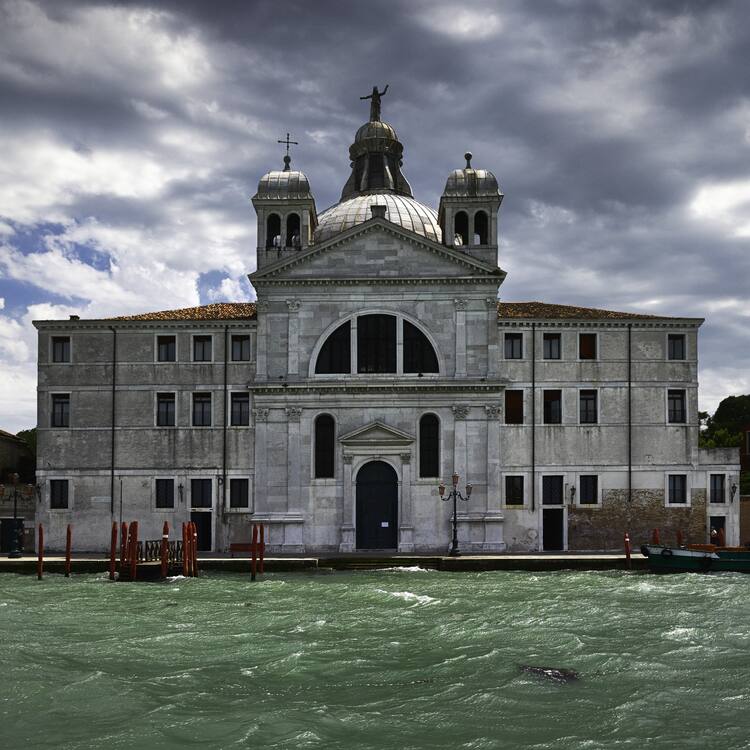
 View photos from OUR PLACE the World Heritage collection
View photos from OUR PLACE the World Heritage collection
